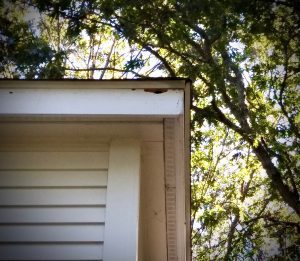“HELP! SQUIRRELS ARE CHEWING ON MY HOUSE!”
By Chris Williams on July 30, 2018.
Mice might chew openings into little spaces and rats will chew bigger openings into bigger spaces, but squirrels take top honors when it comes to gnawing. A determined squirrel can cause a great deal of damage to a structure. Squirrels will gnaw to get to a food source or a nesting site, to create nest material, or just because they like the ritual.
DO SQUIRRELS HAVE TO CHEW TO KEEP THEIR TEETH FROM GROWING?
You may have heard it said that rodents (mice, rats, and squirrels, to name a few) have to constantly gnaw on something to keep their incisors from growing too long. That’s the justification we use sometimes when rodents cause damage around our homes but it’s not quite true. Although both their upper and lower incisors do grow continuously, they are able to keep their teeth filed down and sharpened by simply grinding them against each other. Of course, gnawing on objects helps too.
Besides prominent incisors, squirrels and other rodents have extra strong jaws to help with gnawing. Squirrels will chew on many items around homes including wood, aluminum, lead, copper, plastic, vinyl siding, sheet rock, asphalt, and mortar, virtually anything that is softer than the hard enamel on their teeth.
YOUR ATTIC IS OFTEN THE TARGET
Around homes, most of the squirrel chewing damage is in an attempt to get into an attic or roof void space for nesting or protection from the elements. Damage will be seen to soffits, fascia, trim, louvers, vents, dormers, around knotholes, and other structures near the roof. Rotting or damaged wood near the roofline is especially susceptible to gnawing. But squirrels will also gnaw on deck furniture, railings, bird feeders, plastic garbage can lids, and just about anything else that strikes their fancy.
An opening gnawed by a gray squirrel is generally 3-4 inches wide. A squirrel will enlarge an existing opening or will create a new opening if it can get a purchase with its teeth on a corner or an edge. The edges of a recently gnawed area on wood will be lighter-colored, rough, and splintery, and you may find small chewed pieces below. In general, the older the gnawed opening, the darker and smoother the edges will become due to weather and frequent contact with the oily hair of the squirrel or squirrels using the opening.
SQUIRRELS IN THE ATTIC? YOU NEED PROFESSIONAL HELP
Trying to stop a squirrel from its mission to get into your attic

Flying squirrels chewed through woodpecker damage to access this attic. Z. Ciras.
can be a real challenge, especially if you’re dealing with a pregnant female who really wants the comfort of that space to give birth. Our nuisance wildlife experts at Colonial Pest though have outwitted and removed many a squirrel. If you’re attempting to exclude the squirrel on your own you have to be very careful that you do not seal baby squirrels into the space. Without mom, they will soon die…and smell…and attract flies and other insects.
We make sure there are no nursing young present and then we use special excluder devices that let squirrels out of the space but keep them from getting back in. Our work doesn’t stop there, we can find and seal openings and reinforce weak areas that squirrels are using as chew toys.
For more on gnawing damage from squirrels, check out these Colonial blogs:
• What Does Squirrel Chewing Damage Look Like?
• How Do Squirrels Get into Attics?
• What’s the Best Way to Seal Squirrels Out?